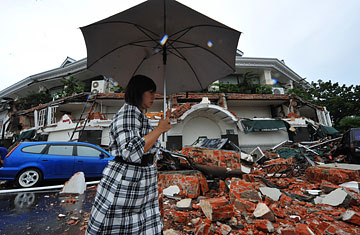
A woman walks past a collapsed hotel in Padang, Indonesia, on Oct. 1, 2009
Sooner or later, the citizens of Padang feared, they would be next. Sitting on the same earthquake fault line that triggered the deadly 2004 Asian tsunami, the Indonesian city of 900,000 on the island of Sumatra is one of the world's most vulnerable to seismic activity. Just after 5 p.m. local time on Sept. 30, disaster finally struck when a 7.6-magnitude earthquake jolted Padang, killing at least 529 people, according to the nation's Social Affairs Ministry.
The death toll is expected to climb dramatically. Indonesia's National Disaster Management Agency announced on Thursday that some 500 buildings had collapsed in the city, with thousands of people still trapped under the rubble. Hospitals, mosques, schools and hotels tumbled to the ground, according to witnesses interviewed on Indonesian television. Outlying areas closer to the earthquake's epicenter have essentially been cut off by landslides. With power down and rain pelting the region, it's impossible to determine yet how badly those districts were affected. But government officials, including the head of Indonesia's Health Ministry, expressed fears that thousands of people may have perished. The Indonesian government has committed about $10 million to the relief effort, with even the Vice President's jet being commandeered to fly in emergency supplies.
Aftershocks continued to jolt the region a day after the quake, with one measuring 6.8 on the Richter scale striking Thursday morning. With thousands of islands strewn across a volatile fault zone, Indonesia is often shaken by earthquakes. But the past few years have proven particularly deadly. The 2004 Boxing Day tsunami and earthquake claimed 130,000 lives in Aceh, the northwestern tip of Sumatra that is not far from Padang on the western side of the island. In 2006, an earthquake hit the metropolis of Yogyakarta on the island of Java, killing more than 5,000 people. (A day before Padang was jolted, a South Pacific earthquake triggered a tsunami around the Samoan islands and Tonga, killing more than 100 people, but scientists are expressing reservations that the two sets of seismic activity along the so-called Ring of Fire were related.)
Earlier this year, Padang mayor Fauzi Bahar told al-Jazeera television that he had asked for funds for potential earthquake relief and management given his city's precarious position on a tectonic fault line. His request, he said, was turned down by national authorities. In retrospect, the denial may look unwise. But Indonesia is a cash-strapped country with many cities located in unstable geological sites. As Padang digs out from this latest devastation, other Indonesians are no doubt wondering who will be the next target of nature's wrath.
